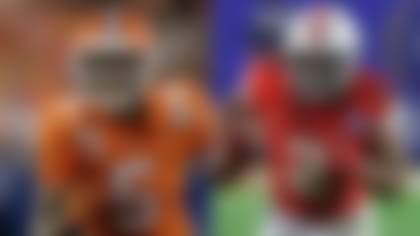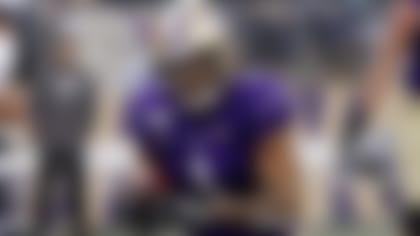After months of build-up, the 2020 hit football fans like a shot of adrenaline, with Round 1 kicking off Thursday. Over the span of three days, we'll ingest 250-plus selections, numerous trades and a whole heap o' hot takes. In such a frenzied environment, with action involving all 32 teams, it can be hard to determine which organizations are really maximizing their draft capital.
In an attempt to quantify the impact of each draft pick, I've turned to a model I developed that in the context of the franchise they ended up with. This means mapping out their production according to team personnel, coaching philosophies and opponents faced.
Per my model, these are the five best values from Round 1 of the 2020 , weighing the players' projected output against where they were selected:
Drafted No. 28 overall.
My "neutral" team model, which ranks players independent of team fit, had Queen as the 16th best player overall. So the Ravens getting him at Pick No. 28 -- especially considering his fit on that roster -- represents the best value in the first round, per my model. The 12.5 tackles for loss he produced last season at LSU is only the tip of the iceberg in terms of the predictive metrics that show why he's such a great value. Queen had 16 pressures (tied for the most among linebackers in the SEC) on 76 pass-rush snaps (third-most among linebackers in the SEC), per PFF. He was also super efficient in coverage, recording the second-fewest yards allowed per coverage snap (0.5 yards) despite having the most snaps in coverage by any linebacker in the SEC (363).
What the data is basically telling us is that Queen is an incredibly versatile player who projects to help the second level of any defense. But his impact should be even more pronounced now that he's paired with the Ravens. In 2019, Baltimore blitzed at the highest rate of any team since 2016 (50.8 percent), per Next Gen Stats. When the Ravens rushed four or fewer pass rushers, they only managed a 17.1 QB pressure rate (the only team under 19 percent on non-blitzes). Queen's presence on the field forecasts an increase in their ability to be multiple and pressure opposing QBs without having to rely on blitzing.
Drafted No. 17 overall.
In my neutral model, no receiver ranked higher than Lamb. When I track him with computer vision, his Oklahoma resume shows the greatest ability to change direction and speed to adapt to where the ball is thrown. PFF adds that he was able to break 26 tackles (ranking second-best in the nation), meaning once the ball was in his hands, he kept it moving downfield. Now, add all of this ability and production into the Cowboys' offense -- to a receiving corps that includes four-time Pro Bowler Amari Cooper and rising third-year pass catcher Michael Gallup -- and the NFC East could very much be the Cowboys' to lose. Further, blocking the division rival Eagles from selecting Lamb (Philly picked receiver Jalen Reagor four slots later) is a pretty savage move.
Drafted No. 8 overall.
It takes a lot for me to assign the word "value" to any player selected in the top 10, but my model views Simmons as the second-best overall player in the entire draft. With a Clemson college resume that includes enough data to evaluate him as an edge defender, slot corner, safety and off-ball linebacker -- and even some reps as an outside corner -- Simmons immediately improves the Cardinals' potential in the very difficult NFC West. Simmons produced 23 pressures on 70 pass rushes last season, which equates to an FBS-best 32.9 percent pressure rate, while his 56.5 passer rating allowed in coverage ranked No. 1 in the ACC amongst safeties (with a minimum of 25 targets, per PFF). For a Cardinals team that allowed the second-most passing yards per game in 2019 (281.9 yards) and made a in free agency, selecting a versatile player who can help against the pass makes total sense. Teams are more likely to have to throw late in games to beat Kyler Murray and this dynamic offense, and Simmons immediately changes their potential to do so effectively. Not to mention that Simmons will help in the run game (the Cardinals ranked 24th last season, allowing 120.1 yards per game).
Drafted No. 15 overall.
Jeudy could have easily been a top-10 pick in most draft classes. My model has him of teammate Henry Ruggs, who was the Thursday night at No. 12 overall to the Raiders. My computer vision measurements show that his explosiveness off the line of scrimmage was faster than Ruggs when measured at game speed from Alabama footage last season. Forecasting his usage alongside Courtland Sutton -- at first blush, this likely means Jeudy will line up more often in the slot -- helps optimize the pass-game opportunity for quarterback Drew Lock in his second season. Jeudy should feel at home in that alignment, as he ran 207 routes (58.8 percent) out of the slot in college last year, catching 47 passes and 7 TDs on 64 targets, per PFF.
If you play , keep an eye on Sutton this year and consider Jeudy a WR2/Flex option (my model still flags their O-line, otherwise the outlook would be even better for both).
Drafted No. 32 overall.
While I have D'Andre Swift ranked higher in my neutral-fit model, Edwards-Helaire is a fit-match for Kansas City's offense that skews the relevant stats to create a ton of upside for the reigning champs. The LSU product is my model's highest-rated pass-catching back, as measured by route diversity and precision, in addition to yards after the catch adjusted for route type (in 2019). On the ground, Edwards-Helaire's ability to avoid run-stopping contact (as measured by positive yards earned when hip direction changed when a defender is within 3 feet) ranked second best among 2020 draft RBs last season. The Chiefs used play-action on 28.8 percent of dropbacks (fifth-highest in the 撸先生AV per NGS), and factoring in Edwards-Helaire's proficiency as both a runner and pass catcher means Kansas City's potential efficiency increases.
Follow Cynthia Frelund on Twitter .











